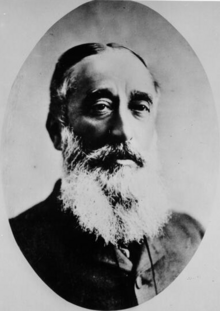Henry F. Teschemacher
Henry F. Teschemacher | |
|---|---|
 | |
| 9th Mayor of San Francisco | |
| In office October 3, 1859 – June 30, 1863 | |
| Preceded by | E. W. Burr |
| Succeeded by | Henry Perrin Coon |
| Personal details | |
| Born | February 16, 1823 Boston, Massachusetts |
| Died | November 26, 1904 (aged 81) Territet, Switzerland |
| Political party | People's Party |
| Profession | Trader, artist, real estate agent |
Henry Frederick Teschemacher (February 16, 1823 – November 26, 1904) served as the 9th mayor of San Francisco from October 3, 1859, to June 30, 1863.
He was born in Boston, Massachusetts and worked for a Boston shipping house around the 1840s. The firm sent him to San Francisco, California in 1846, where he traded goods for furs, tallow, and hides. With the start of the Gold Rush six years later, he bought a great deal of real estate in what later became San Francisco. He also sketched a drawing of the village of which he would become mayor, called View of Place of Anchorage of Yerba Buena.
Teschemacher joined the Vigilance Movement,[1] serving in the vigilante-led trials of suspected criminals. Through his work with the vigilantes, he became known as a person who stood for law and order[2] and was the choice of the People's Party for mayor in the 1859 election. He won due to divisions in the Democratic ranks over slavery.
His first months in office were relatively calm. He kept tabs on city spending and made few public appearances save to dedicate the city's first streetcar line. He also doubled the size of San Francisco's police force. While Teschemacher was Mayor of San Francisco, the American Civil War erupted: San Francisco coped with disrupted trade with the East by buying stock in silver mines and establishing factories that sold goods not only within the city itself but also in Asia, beginning San Francisco's path to economic self-sufficiency. 1861 also saw the completion of the New York to San Francisco telegraph line, with Teschemacher sending a congratulatory telegram to New York's mayor.[3][4]
After leaving office, Teschemacher was a real estate agent until 1882. He retired to Europe, briefly appearing in San Francisco in 1892. He produced a lithograph entitled Life In California, by the Endicott Company. He died in Territet, Switzerland on November 26, 1904.
References
[edit]- ^ Academy of Pacific Coast History (1919). "San Francisco Committee of Vigilance of 1851 | December 10, 1851". Publications of the Academy of Pacific Coast History. Allen County Public Library Genealogy Center. Berkeley, Calif. : University of California. pp. 712–712, 806, 813. Retrieved 12 March 2020.
Report on Collecting Fines : The Committee appointed to divide the City in districts and appoint members to collect money from the inhabitants to defray the expenses of the Committee of Vigilance report the following : East and West : [...] Pine Street [from Kearney Street East] H F Teschemacher[...] Appendix A : List of Members of the Committee of Vigilance[...]Teschemacher, Henry Frederick 107[105]
- ^ "Daily Alta California — 13 June 1851". The Daily Alta California. 13 June 1851. Retrieved 12 March 2020 – via California Digital Newspaper Collection.
Organization of the Vigilance Committee:[...][T]he citizens whose names are hereunto to attached, do unite themselves into an association, for the maintenance of the peace and good order of society and the preservation of the lives and property of the citizens of San Francisco, and do bind ourselves, each unto the other, to do and perform every lawful act for the maintenance of law and order, and to sustain the laws when faithfully and properly administered. But we are determined that no thief, burglar, incendiary or assassin shall escape punishment either by the quibbles of the law, the insecurity of prisons, the carelessness or corruption of the police, or laxity of those who pretend to administer justice.[...]F. O. Wakeman, H. F. Teschemacher, J. Thompson Huie,[...]
- ^ Singer, Jane (2019). The War Criminal's Son: The Civil War Saga of William A. Winder. U of Nebraska Press. p. 10. ISBN 978-1-64012-186-7.
[O]n October 25, 1861, a long-awaited telegraph line finally connected New York and San Francisco. [...] "San Francisco to New York sends greetings and congratulates her on the completion of the enterprise which connects the Pacific with the Atlantic. May the prosperity of both cities be increased, and the projectors of this important work meet with honor and reward."
- ^ "THE OVERLAND TELEGRAPH.; Completion of the Line to San Francisco. A Message from the Mayor of San Francisco to the Mayor of New-York". The New York Times. 1861-10-26. ISSN 0362-4331. Retrieved 2020-03-12.
ST. JOSEPH, Friday, Oct. 25. : The Pacific Telegraph was completed to San Francisco yesterday, and was in fine working order last evening. The first through message transmitted over the line is from STEPHEN J. FIELD, Chief Justice of California, in the absence of the Governor, to ABRAHAM LINCOLN, President of the United States. In consequence of the line being closed east of here before we received notice of the line working last night, we were obliged to hold the message, with others, over night. The enterprise is a complete success.
Sources
[edit]- Heintz, William F., San Francisco's Mayors: 1850-1880. From the Gold Rush to the Silver Bonanza. Woodside, CA: Gilbert Roberts Publications, 1975. (Library of Congress Card No. 75-17094)

